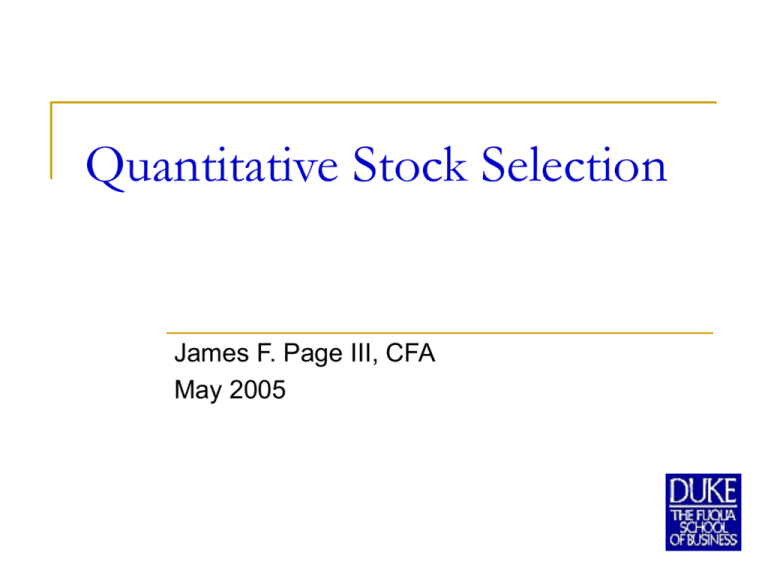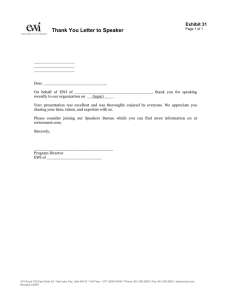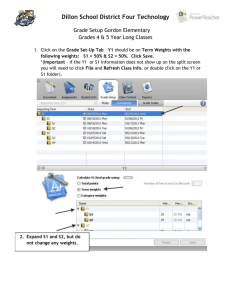Long/Short Trading Strategy - Duke University's Fuqua School of
advertisement

Quantitative Stock Selection
James F. Page III, CFA
May 2005
Project Summary
1.
2.
3.
4.
5.
6.
7.
8.
Why Quant Selection is Attractive
Methodology
Historical Back Testing
Model Results
Dynamic Weights / Regime Change
Benchmarks
Next Generation Models
Concluding Thoughts
I. Quantitative Stock Selection
Quant Stock Selection
Premise
(1) In aggregate, certain fundamental, expectational, and
macro variables may contain valuable information in
predicting stock returns
(2) Not unlike traditional fundamental analysis, just more
systematic
Quant Stock Selection
Pros:
Anecdotal evidence suggests ~80% of stock picking is done ‘by
hand’ (individuals making calls on fundamentals)
Relies heavily on talent (or luck) of individual analyst
Individuals can only process so much information (sector focus)
Human nature suggests cognitive biases likely
Market structure may perpetuate mis-pricings (Street incentives,
value weighted benchmarks, short sale restrictions)
Little academic research on subject (trade rather than publish)
Evidence suggests that investors systematically over pay for
‘growth’
Quantitative selection is scaleable
Quant Stock Selection
Cons:
Black box nature of model
Explain approach without revealing too much information
Attribution analysis – must be able to explain performance
Protecting against common modeling errors
Credibility of simulated results
Adapting to individual client restraints
Quant Stock Selection
Market Neutral
Generate returns from both undervalued and overvalued stocks
At present, high market valuation = low future returns
Market exposure is commodity but good stock selection is valued
(higher management fees)
Low return expectations combined with geo-political environment
suggests absolute return approach prudent
II. Methodology
Methodology
1.
Hypothesize
2.
Back Test
3.
Develop candidate list of potential factors that may assist in
predicting stock returns (valuation, growth, etc.)
‘Priors’ reduce data mining
Decide on “universe” for testing (capitalization, index, sector, etc)
Use sorting or regressions to test individual candidate variables
FactSet’s AlphaTester currently available to Duke students
Rebalance
Periodically rebalance portfolios (monthly, annually, etc.)
Methodology
4.
Analyze Results
5.
Consider factor performance and consistency (both long and
short candidates) in predicting returns balanced against
turnover
Select most promising factors for inclusion in the model
Weight
Once individual factors selected must decide on weights for
final model by either:
a)
b)
‘Eye balling’ best factors and assigning weights for a scoring
model
Pushing individual factor portfolios into a mean-variance
optimizer
III. Historical Back Testing
Historical Back Testing
Access to reasonably accurate historical data is costly
FactSet’s AlphaTester is currently available to Duke students
Two approaches common in practice
Must protect against common modeling errors
Regression of factors on security returns (Panel, etc.)
Sorting universe into fractiles based on factor characteristics (AlphaTester)
Survivorship bias
Information / reporting lags
Data mining
Inaccuracies in data
Credibility of simulated returns is critical
Historical Back Testing
Term 3 Model Discredited
Errors in Historical Returns
Scrub Example.xls
Survivorship Bias
Difficult to rule out unless you spend a lot of time examining results
Fractile Misspecification
MSFT grouped in F1 Div Yield for 85-04 because of Special
Dividend
Betas not believable
Subject to similar errors as returns information
Makes market neutral simulation difficult
Combing factors into comprehensive model increases complexity
Historical Back Testing
To Mitigate Potential Errors:
Universe Selection is critical component
Market Cap weighted
Adds to turnover (98-00)
Unstable sector allocations
Less undervalued firms to buy
Revenue weighted
Sector bias
Less overvalued firms to sell
Actual Indices (Preferred method)
Limit universe to actual benchmark
Limit survivorship bias
Historical indices available (but option not turned on for Duke)
Greatly enhance credibility – look to acquire for next year’s class
Historical Back Testing
To Mitigate Potential Errors:
Factor Syntax
If you do not get this right – data is worthless (lots of opportunities
to get it wrong)
Consider consolidating our “approved” syntax for future students as
starting point
Expectational (instead of accounting/fundamental) produced
significantly fewer errors
Survivorship Bias
Selecting “Research Companies” does not protect without:
Appropriate Syntax on Factors
Correct specification of Universe
Sanity checks on early period companies
# of NA companies can be signal
Errors
You must clean historical data
Consider median returns as back of envelope option
Historical Back Testing
Recommendations:
Use historical indices as universe
S&P 500
Barra 1000
Start with “approved” list of factor syntax
Clean historical results (particularly returns)
Do not rely on betas to construct market neutral portfolio
Research ways to limit reliance on AlphaTester
Look for other data providers – ask managers what they use
Interface with CompuStat/IBES directly?
Once comfortable with model, begin sorting real time ASAP
IV. Model Results
Model Results
Desired Universe: S&P 500
Why:
‘Considered’ to be highly efficient
Value weighted index suggests low hanging fruit
Historical data for testing is plentiful and reasonably accurate
Highly liquid (market impact costs and borrow)
Very scaleable because of market capitalizations
Actual Universe:
First choose US Companies with highest sales (~ 500)
Had to switch to Market Cap because of data limitations
Model Results
Universe Comments:
Unstable during bubble period (1998-2000)
Less undervalued firms to buy (but more overvalued firms to sell)
Sector allocations float with market sentiment
Other:
Rebalanced “official” results annually due to time consuming nature
of “cleaning returns”
Equal number of companies in each bucket
Equal weight returns
Did not impose sector constraints
Included two groups of Factors – Fundamental and Expectational
Actively looking for “Quality” factor to add to the model
Assume “beta” exposure is equal is both portfolios – probably
conservative
Results seem “too good” – further ‘cleaning’ necessary
Model Results
Individual Factor Performance
Monthly Statistics 1989 – 2004
Long Factors correlated with Value and visa versa
View Portfolios
Date
Mean
Median
High
Low
St Dev
Correlations
S&P 500
500 / Growth
500 / Value
F1
1.31%
1.65%
20.50%
-14.59%
4.87%
82%
70%
89%
Long Factors
F2
E1
1.14%
1.47%
1.13%
1.76%
11.78%
14.15%
-12.73% -15.00%
3.74%
4.96%
81%
66%
89%
83%
69%
91%
E2
1.47%
1.87%
13.84%
-19.03%
5.40%
F1
1.09%
1.29%
27.40%
-19.64%
6.30%
89%
78%
93%
75%
81%
59%
Short Factors
F2
E1
0.95%
0.85%
1.08%
1.26%
16.35%
28.57%
-17.20% -25.75%
5.30%
7.35%
85%
85%
75%
73%
78%
60%
E2
0.77%
1.34%
23.83%
-19.91%
5.74%
75%
78%
63%
Model Results
Fixed Weighting Scheme
Long
Weights
Short
Weights
Views
F1
F2
E1
E2
Scoring
18%
18%
27%
36%
Optimized
10%
10%
30%
50%
F1
F2
E1
E2
-10%
-20%
-30%
-40%
-10%
-16%
-24%
-50%
Returns
Volatility
7.8%
20.3%
7.8%
17.6%
Model Results
Scoring Model Heat Map
1989
1990
1991
1992
1993
1994
1995
1996
1997
1998
1999
2000
2001
2002
2003
2004
Long
29.3%
-11.4%
48.0%
16.3%
23.0%
1.0%
38.2%
25.7%
30.1%
8.0%
10.0%
20.3%
4.9%
-11.7%
68.2%
22.6%
Short
27.8%
-5.0%
39.4%
7.6%
12.8%
2.9%
23.4%
13.7%
18.6%
36.7%
37.6%
-26.2%
-37.1%
-28.2%
39.1%
12.5%
Portfolio
1.5%
-6.4%
8.6%
8.7%
10.2%
-1.9%
14.8%
12.0%
11.5%
-28.8%
-27.5%
46.5%
42.1%
16.5%
29.1%
10.1%
Model Results
Summary Statistics
Mean
Geometric
Median
High
Low
St Dev
Turnover
Long
20.2%
19.8%
21.5%
68.2%
-11.7%
20.8%
83.2%
Short
11.0%
8.6%
13.2%
39.4%
-37.1%
24.6%
89.9%
Portfolio
9.2%
7.8%
10.1%
46.5%
-28.8%
20.3%
V. Dynamic Weights /
Regime Change
Dynamic Weights / Regime Change
A factor’s effectiveness may vary in different states of
nature (PE ratios impacted by inflation)
Certain market / macro conditions may favor growth or
value (value was dog in late 1990s)
Dynamic factor weights allow model to capitalize on
conditional information
Few managers currently employ dynamic weighting
schemes
This area “is the Holy Grail” of Quant Strategies
Dynamic Weights / Regime Change
Forecasting Regime Change
Inflection point for style (growth or value) relative performance
Used S&P 500 Barra Value and Growth Indices as Proxies
Examined macro economic variables that might assist in
forecasting these inflection points
Two variables demonstrated “promise” in forecasting style relative
performances over the following year
Dynamic Weights / Regime Change
Regime Change – Factor 1
Correlation Matrix
Variable RegimeChange
Variable
1.000
RegimeChange
0.436
1.000
Regression Statistics
R
R Square
Adj.RSqr
Std.Err.
# Cases
0.436
0.191
0.187
0.446
240
Summary Table
Variable
Coeff.
Std.Err.
t Stat.
P-value
Intercept
0.421
0.029
14.616
0.000
Variable
0.216
0.029
7.484
0.000
Dynamic Weights / Regime Change
Regime Change – Factor 2
Correlation Matrix RegimeChange
RegimeChange
1.000
Variable
0.411
Variable
1.000
Regression Statistics
R
R Square
Adj.RSqr
Std.Err.
# Cases
0.411
0.169
0.165
0.452
240
Summary Table
Variable
Coeff.
Std.Err.
t Stat.
P-value
Intercept
0.421
0.029
14.424
0.000
Variable
0.203
0.029
6.952
0.000
Dynamic Weights / Regime Change
The Same Can Be Applied to View Portfolios
Expectational Factor #2 and Regime Change Factor #1:
Prediction of Long outperforming Short
Correlation Matrix
Variable
Variable
1.000
E2 Long / Short
0.435
E2 Long / Short
1.000
Regression Statistics
R
R Square
Adj.RSqr
Std.Err.
# Cases
0.435
0.189
0.184
0.388
169
Summary Table
Variable
Coeff.
Std.Err.
t Stat.
P-value
Intercept
0.776
0.030
25.848
0.000
Variable
0.176
0.028
6.240
0.000
Dynamic Weights / Regime Change
The Same Can Be Applied to View Portfolios
Expectational Factor #2 and Regime Change Factor #2:
Prediction of Long Outperforming Short
Correlation Matrix
E2 Long / Short
E2 Long / Short
1.000
Variable
0.427
Variable
1.000
Regression Statistics
R
R Square
Adj.RSqr
Std.Err.
# Cases
0.427
0.183
0.178
0.390
169
Summary Table
Variable
Coeff.
Std.Err.
t Stat.
P-value
Intercept
0.788
0.030
25.922
0.000
Variable
0.171
0.028
6.110
0.000
VI. Benchmarks
Benchmarks
Value or Equal Weight?
Since 1990, EWI has outperformed by 177 basis points
Turnover for EWI is 6x which begs the question …
Can we separate turnover between model signals and weighting
scheme?
Metric
Annual Total Return ('90-'04)
Volatility ('90-'02)
Annual Turnover ('92-'02)
S&P 500
10.94%
15.27%
4.97%
S&P 500 EWI
12.71%
16.04%
29.13%
Benchmarks
Value or Equal Weight?
Significant Implications for Sector Weights / Tracking Error
Sector
Consumer Discretionary
Consumer Staples
Energy
Financials
Health Care
Industrials
Information Technology
Materials
Telecommunications Services
Utilities
S&P 500
11.9%
10.5%
7.2%
20.6%
12.7%
11.8%
16.1%
3.1%
3.3%
2.9%
EWI
17.6%
7.2%
5.5%
16.4%
10.9%
11.3%
16.1%
6.4%
2.0%
6.6%
Relative
Weighting
47.8%
-31.5%
-23.2%
-20.6%
-13.8%
-3.8%
0.4%
107.1%
-39.1%
123.8%
Benchmarks
Value or Equal Weight?
Correlations drift through time – implications for tracking error
Benchmarks
Value or Equal Weight?
EWI had positive loading on the size premium
EWI has significant exposure to the value premium
Fama-French Risk Factor Exposures
Intercept
Market
SMB Premium
HML Premium
R-squared
500
0.413
1.009
(0.181)
0.050
99%
EWI
0.385
1.060
0.060
0.370
93%
Source: http://mba.tuck.dartmouth.edu/pages/faculty/ken.french/data_library.html
Benchmarks
Value or Equal Weight?
EWI has 82% correlation with 500 / Barra Growth
EWI has 96% correlation with 500 / Barra Value
Further proof of value tilt
500
EWI
500 / Barra Growth
500 / Barra Value
500
100%
93%
96%
94%
EWI
500 /
Barra Growth
500 /
Barra Value
100%
82%
96%
100%
81%
100%
Benchmarks
Value or Equal Weight?
Obvious Pros and Cons to both
EWI benchmark will make returns look less impressive, but
help explain turnover
EWI may be a better match for style
Provide more stable weighting for sector allocations
Equal weight is newer idea – historical data is limited
If possible, choice should match weighting scheme of
portfolio
VII. Next Generation Models
Next Generation Models
Refining Dynamic Factor Weights
Preferably done outside of FactSet
Migration Tracking
May contain information to enhance returns or limit turnover
♥ Score of Stock X
Fractile 1
♥
♥
♥
Fractile 2
Fractile 3
♣
♥
♣
♥
♣
♣
Fractile 4
Fractile 5
♥
♣ Score of Stock Y
♥
♥
♥
♣
♣
♣
♣
1
♥
♣
♣
2
3
4
5
6
Periods
7
8
9
10
Next Generation Models
Modified Versions of S&P 500 Model
Separate Models for Sector and Stock Selection
More Conservative
More positions
Limited tracking error
More Aggressive
Directional
Less positions
Leverage
Other Domestic Models
S&P Mid-Cap 400 / Russell 2000
International Models
Developed / Emerging markets
VIII. Concluding Thoughts
Concluding Thoughts
Theoretical
How long will excess returns exist
How to stay ‘ahead of the curve’
Implementation
Cost of data
Credibility of simulation
Returns during first 12 – 24 months
Balance between turnover and model signals
Concluding Thoughts
Overall
Quantitative Stock Selection Appealing
Outperformance Seems Possible
Long/Short Consistent with Absolute Return Approach
Bio
James F. Page III
Jimmy became interested in quantitative stock selection during
Campbell Harvey’s Global Asset Allocation and Stock Selection
class and a follow-up course dedicated to quantitative stock
selection. He received his Bachelor of Science degree from the
University of Florida and will receive his MBA from Duke University’s
Fuqua School of Business in May 2005. Prior to enrolling at Duke,
he spent four years in the Equity Research Department of Raymond
James & Associates in St. Petersburg, FL. He is also a CFA charter
holder.





